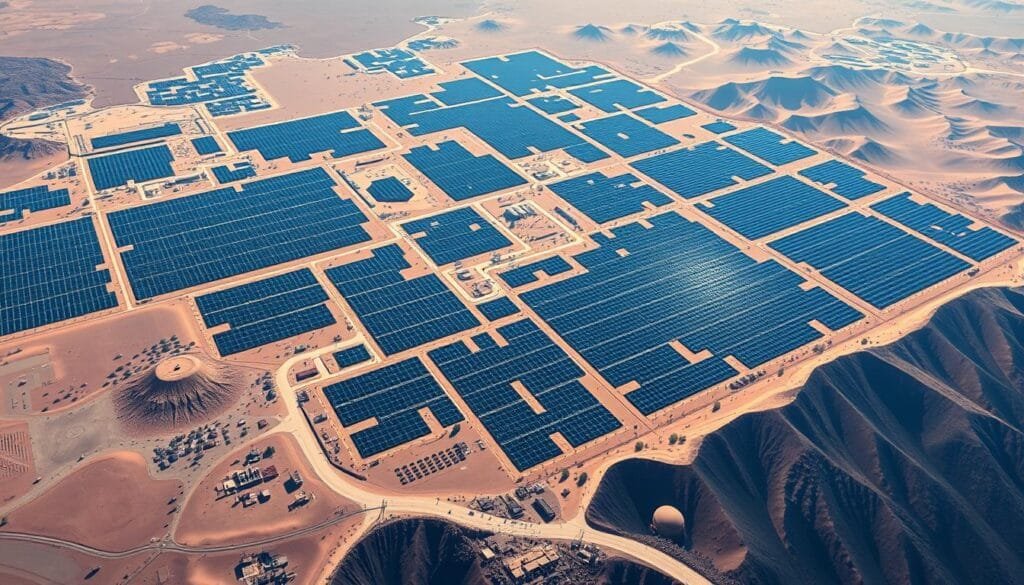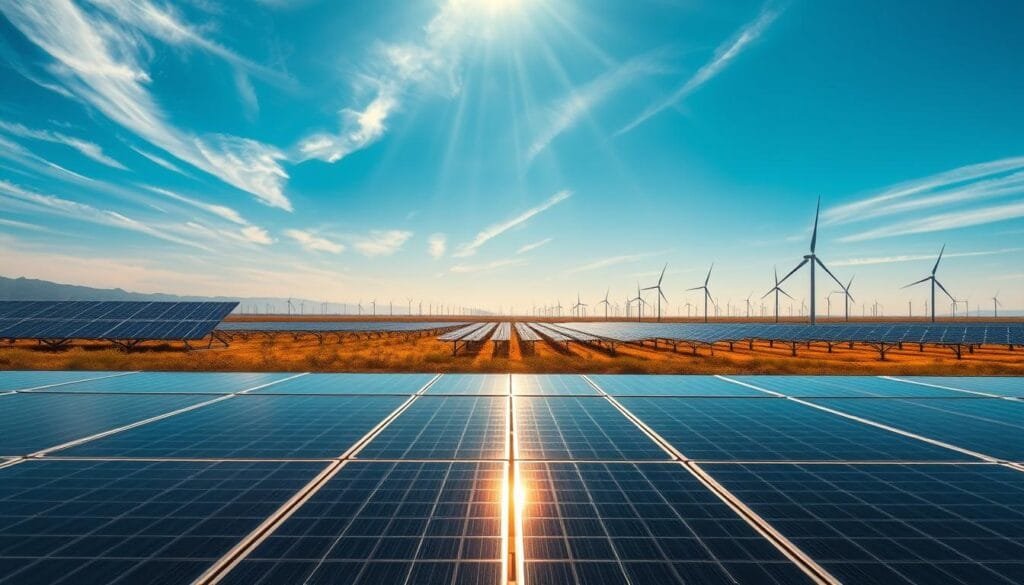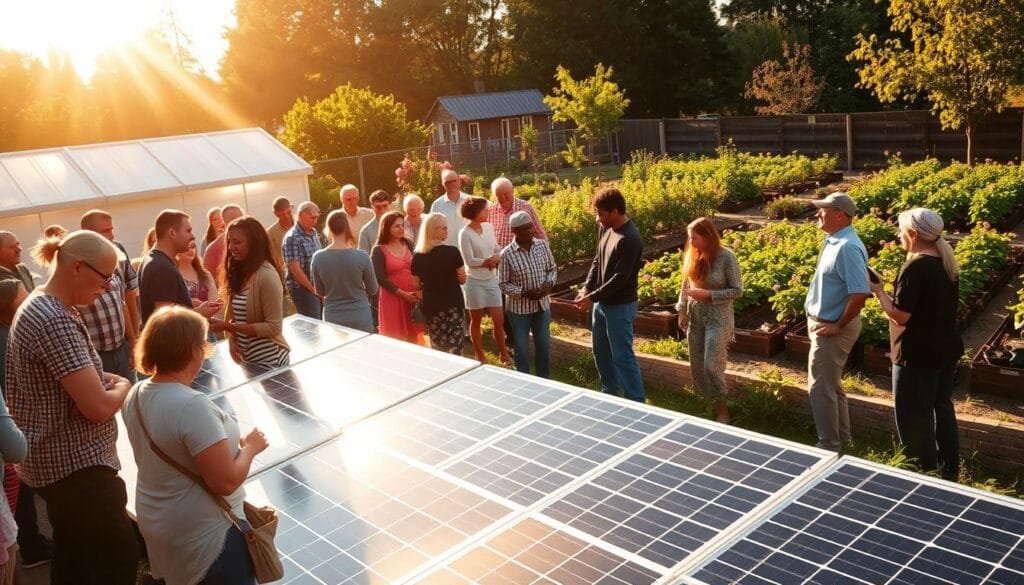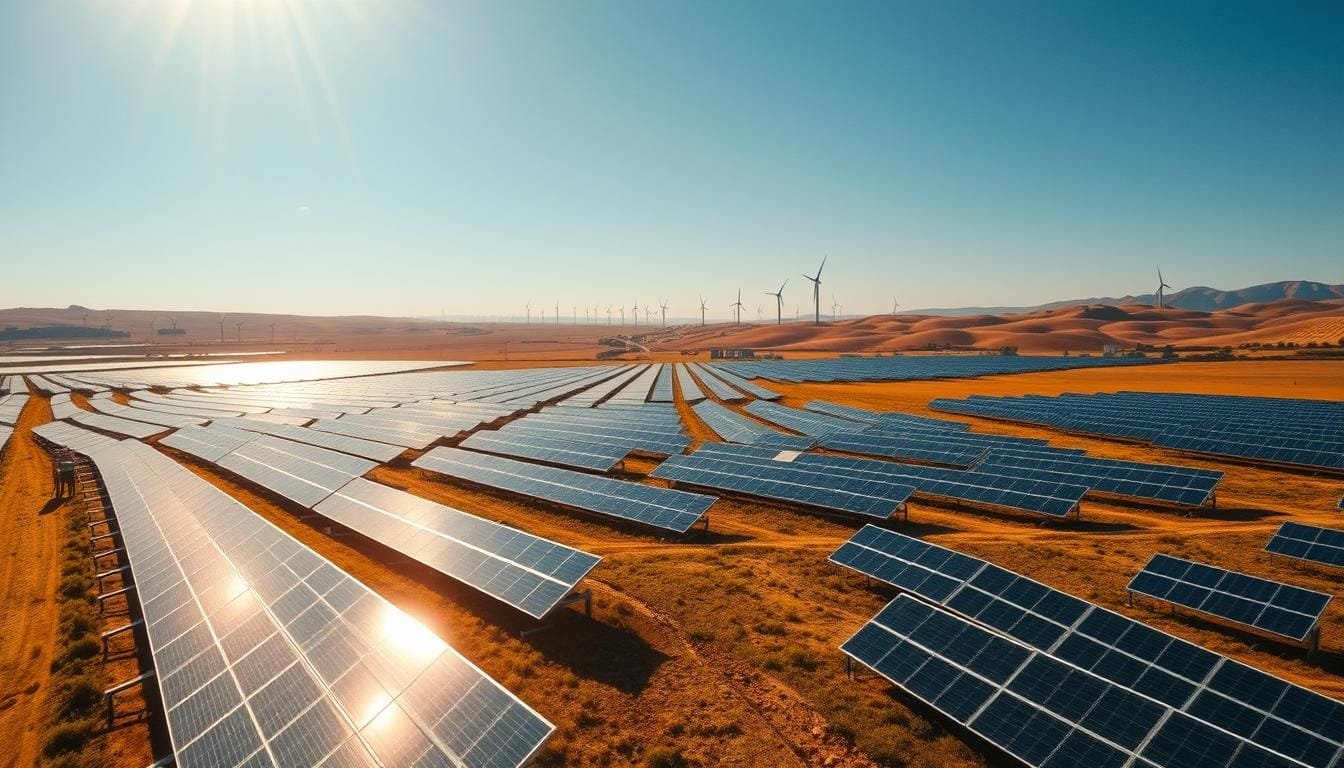Google has made a huge step towards clean energy by getting 900 MW of solar power in Texas. This move is a big deal for using renewable energy. It shows Google’s strong commitment to green energy.
Google’s solar parks plan is more than just buying energy. It’s about changing the way we think about renewable energy in the U.S. By investing in 900 MW of solar parks, Google is leading the way in clean energy.
This project shows Google’s dedication to green tech. With such big investments in renewable energy, Google is setting new standards for companies to be environmentally responsible.
Key Takeaways
- Google’s 900 MW solar parks represent a significant milestone in renewable energy development
- The project will create approximately 3,000 U.S. jobs in manufacturing and construction
- Over 1.3 million American-made solar modules will be utilized
- The initiative supports Texas’s growing renewable energy sector
- Google aims to operate on 24/7 carbon-free energy by 2030
Overview of Google’s Renewable Energy Initiatives
Google is leading the way in clean energy. We know how important it is to change how businesses use energy today.
We’re committed to using sustainable energy. Our goals are big. We’ve grown our electricity use a lot while finding new ways to use renewable energy. Here are some key points:
- Contracting over 3,700 megawatts of renewable energy generation capacity
- Targeting 100% carbon-free energy operations by 2030
- Investing billions in sustainable infrastructure across the United States and Europe
Strategic Clean Energy Vision
Clean energy is key for both the planet and business. Our electricity use has almost quintupled. This growth needs new, green solutions.
Impact of Solar Parks
Solar parks are a big part of our plan. They help us cut down on carbon and push for new tech and jobs in clean energy.
Our efforts show that being green and profitable can go hand in hand. We’re setting a high standard for tech companies worldwide.
Understanding Solar Power
Solar energy is a game-changer for clean electricity. We dive into how utility-scale solar farms work. They’re changing the game in renewable energy.
Basics of Solar Energy
Solar energy uses sunlight to make electricity. Solar panels turn sunlight into electricity with special materials like silicon. When sunlight hits these panels, it creates electricity.
- Photons strike solar panel surface
- Electrons are excited within semiconductor materials
- Electric current is generated
- Inverters transform DC to alternating current (AC)
How Solar Parks Operate
Utility-scale solar farms, like Google’s 900 MW projects, are complex systems. They use solar power agreements to grow renewable energy.
| Solar Park Characteristic | Specification |
|---|---|
| Total Modules | 1.3 million |
| Generation Capacity | 900 MW |
| Structural Steel Used | 22,800 tons |
| Employment Generated | 3,000 U.S. workers |
Solar parks use land wisely to catch the most sunlight. They use smart systems to track the sun. This way, they make electricity all day long.
The Scale of 900 MW
Google’s 900 MW of solar parks is a big deal in renewable energy. These solar installations show how much clean energy we can use.
- Enough electricity for about 250,000 average American homes
- As much energy as a medium-sized nuclear power plant
- A big help in cutting down carbon emissions
Understanding Power Generation Capacity
Our solar farms make a lot of clean energy. Google’s 900 MW can power a lot, like 85% of data centers in Dallas.
Comparative Energy Production
Here are some comparisons:
| Energy Source | Capacity | Homes Powered |
|---|---|---|
| Google Solar Parks | 900 MW | 250,000 |
| Typical Coal Power Plant | 600 MW | 180,000 |
| Small Nuclear Reactor | 900 MW | 270,000 |
“Our commitment to renewable energy is not just about generating power, but transforming how we think about sustainable infrastructure.” – Google Energy Team
Building these solar farms shows our commitment to clean energy and the environment.
The Locations of Solar Parks
We’ve placed utility-scale solar farms across the United States. This maximizes environmental benefits and energy efficiency. The choice of location is key for powering sustainable projects renewable energy technologies keep improving.

Our solar installations’ geography shows a thoughtful strategy. We picked areas for their high solar energy output.
Strategic State Selections
Texas is a top choice for our solar projects. The Orion Solar Belt in Milam County is a prime example. We look for:
- Abundant sunlight
- Large areas of land
- Close to energy users
- Good local policies for renewables
Benefits of Location Choices
Our solar farms bring many benefits to local areas and the energy world. By placing them in Texas, we:
- Create jobs locally
- Boost the local economy
- Lower carbon emissions
- Help meet state renewable energy targets
Texas is perfect for our solar projects. It already gets about 30% of its power from renewables. The state has about 70 GW of renewable energy installed.
Economic Impact of Solar Investments
Our renewable energy investments are changing the U.S. economy. Google’s solar parks are making clean energy and boosting local jobs.
The solar industry is creating lots of jobs. Recent numbers show its fast growth:
- Over 219 gigawatts of solar capacity installed nationwide
- Average annual solar deployment growth of 26% over the last decade
- Projected installation of 40-45 GW annually in the next five years
Job Creation in the Renewable Sector
Our green efforts are creating many jobs. The Orion project alone will hire 3,000 U.S. workers.
| Economic Metric | Solar Industry Impact |
|---|---|
| New Module Manufacturing Capacity | 24 GW in 2024 |
| Corporate Solar Users | Nearly 40 GW installed |
| Corporate Solar Pipeline | Over 25 GW |
Local Community Benefits
Our investments help local economies grow. They create jobs, boost supply chains, and increase economic activity. The Levelized Cost of Electricity for solar power has dramatically decreased by 90% over the last decade, making these investments more appealing.
By growing our renewable energy investments, we’re doing more than making clean electricity. We’re also making local communities stronger and creating real job and business opportunities.
Environmental Benefits of Solar Energy
Google is dedicated to reducing environmental impact through solar energy. We invest in clean electricity to change the renewable energy world with new solar technologies. Our solar parks are key in fighting climate change and saving our planet’s ecosystems.

Solar energy has many benefits beyond just clean power. We focus on two main areas:
Reducing Carbon Footprint
Our solar parks cut down greenhouse gas emissions a lot. By making clean electricity, we can:
- Stop thousands of tons of carbon dioxide from being released
- Use less energy from fossil fuels
- Help the world fight climate change
Supporting Wildlife and Land Preservation
We make our solar installations friendly to nature. Our plans include:
- Choosing sites that don’t harm the environment
- Planting native plants around solar panels
- Creating homes for local wildlife
| Environmental Metric | Impact of Solar Parks |
|---|---|
| Carbon Emissions Reduction | Up to 90% less than fossil fuel energy |
| Land Use Efficiency | Little harm to nature |
| Wildlife Habitat Support | More wildlife thanks to smart design |
By caring for the environment, we’re not just making electricity. We’re building a green future for all.
Partnerships in Solar Energy
Our dedication to green energy goes beyond single projects. Google’s solar deals show a smart way to grow renewable energy through key partnerships. These are with energy companies and local governments.
Our green goals rely on strong partnerships. We’ve built key alliances that boost innovation and grow renewable energy in the U.S.
Collaborations with Energy Providers
Our deal with SB Energy is a big win for solar energy. The Orion Solar Belt project highlights the power of working together:
- 900 MW of power
- 1.3 million solar modules
- Jobs for 3,000 U.S. workers
Working with Local Governments
Working with local governments is key to our solar plan. We’ve created a plan that helps communities and grows renewable energy.
| Partnership Aspect | Impact |
|---|---|
| Texas Infrastructure Investment | Over $1 billion |
| Renewable Energy in Texas | Approximately 30% of electricity |
| Projected Data Center Electricity Consumption | Expected to exceed 1,000 terawatt-hours by 2026 |
Our solar deals do more than just make clean energy. They also bring jobs and growth to local areas. We’re changing the energy world, one partnership at a time.
Technological Innovations in Solar Parks
Exploring utility-scale solar farms shows us amazing tech advancements. These changes are making clean energy more efficient and effective. The solar industry is always improving, creating better ways to make renewable energy.
Advances in Solar Panel Technology
Today’s solar panels have seen big changes. The Orion Solar Belt project shows these improvements, using over 1.3 million solar modules made in America. The key upgrades include:
- Higher efficiency photovoltaic cells
- Enhanced light absorption capabilities
- Improved durability and longevity
- Reduced manufacturing costs
Energy Storage Solutions
Energy storage is a big step forward in solar farms. Smart grid technologies help manage energy better. This lets solar parks store extra power and use it when needed most.
Our advanced storage systems can:
- Capture surplus solar energy
- Stabilize electrical grid performance
- Provide reliable power during low-sunlight periods
- Reduce dependency on traditional power sources
These tech improvements are making clean energy more efficient and sustainable. Solar energy is becoming a key part of our future power plans.
Google’s Role in Promoting Solar Adoption
Google is more than just a tech company. We’re leading the way in making the world more sustainable. We’re pushing other big companies to use more solar energy.
We’re using many ways to make solar energy more appealing:
- Demonstrating large-scale renewable investment through the 900 MW Orion Solar Belt projects
- Creating transparent benchmarks for corporate environmental responsibility
- Generating substantial economic opportunities in the renewable sector
Encouraging Corporate Participation
We’re showing others how to invest in solar energy. We’ve put over $1 billion into Texas for cloud infrastructure and data centers. Our solar parks make clean energy and help the economy, creating jobs for 3,000 U.S. workers.
Enhancing Public Awareness
Teaching people about solar energy is key. Our efforts aim to make renewable energy clear and show its benefits. We’re doing workshops, talks, and team-ups to help communities see solar energy’s power.
We dream big: we want to run our whole global operation on clean energy by 2030. This shows that being green and innovative can go hand in hand.
The Future of Solar Energy at Google

Our tech company green goals are driving a big change. Google is leading the way in using clean energy. We have plans to change the way we use energy.
We’re looking beyond just solar energy. We want to make big steps in using and making sustainable energy.
Planned Solar Energy Expansions
Our solar energy plans are exciting:
- We’re growing our solar park to more than 900 MW.
- We’re investing in new solar technology.
- We’re working on better ways to store energy.
Long-Term Renewable Energy Objectives
Google has big goals for renewable energy:
- 100% carbon-free electricity by 2030
- We want to use as much renewable energy as we consume.
- We’re investing in the grid to make it cleaner.
We’re teaming up with energy companies to speed up our green projects. We’re looking at different ways to make energy and using new tech.
Our goal is to lead in making a sustainable future for tech.
By 2030, we want to use clean energy all the time. This shows our commitment to making a big difference in the tech world.
Challenges Faced by the Solar Industry
The solar energy world is facing tough challenges that affect investments in renewable energy. Our industry is dealing with big obstacles that test our strategies for solar energy adoption.
Regulatory Landscape Complexities
Regulatory hurdles are a big challenge for solar development. The solar industry’s flux is greatly influenced by changing policies. These changes create uncertainty for investors and developers.
- Inconsistent federal and state-level incentives
- Complicated permitting processes
- Shifting tax credit regulations
Market Dynamics and Economic Pressures
Market changes are another big challenge for solar energy adoption. The landscape of renewable energy investments is always changing. This is due to competition from traditional energy sources and complex supply chain issues.
Key market challenges include:
- Volatile component pricing
- International trade policy impacts
- Competition from fossil fuel alternatives
Despite these challenges, the solar industry shows great resilience. With over 219 gigawatts of solar capacity installed in the U.S. and an average annual growth rate of 26% in the last decade, we are hopeful about the future of renewable energy.
Community Engagement and Education
We’re dedicated to more than just tech. We know how key community involvement is for renewable energy. We aim to connect and educate, empowering locals to help the environment.

Solar Energy Workshops: Building Knowledge
We create detailed solar energy workshops for residents. These sessions offer hands-on learning on:
- Basic solar energy principles
- Economic benefits of renewable investments
- Environmental advantages of solar power
- Potential personal and community-level opportunities
Encouraging Local Investment in Renewables
We use incentives to boost community solar energy adoption. Our programs show the economic value of renewable energy.
| Community Benefit | Annual Impact |
|---|---|
| Local Job Creation | 130 Union Jobs |
| Community Fund | $10,000 Annual Allocation |
| Educational Scholarships | $2,000 per Student |
| Electricity Bill Credits | $47,000 Annually |
“Education is the most powerful weapon we can use to transform community engagement in renewable energy.” – Clean Energy Expert
We focus on clear communication and real benefits. Our aim is to make solar energy appealing and accessible to communities nationwide.
The Role of Policy in Renewable Energy
Policy is key in shaping the renewable energy world. The United States has a strong set of federal and state incentives. These incentives push for more clean energy and help solar energy grow. Renewable energy policies are changing our energy system.
The Inflation Reduction Act is a big change for solar energy. It offers big incentives for companies and investors to invest in renewables. For example, it gives extra credits for using solar parts made in the U.S. This boosts energy production and local jobs.
Federal Incentives Driving Solar Growth
- Tax credits for solar project development
- Grants supporting renewable infrastructure
- Domestic content bonus credits
- Accelerated depreciation benefits
State-Level Policy Impact
State governments are key in growing renewable energy. Texas is a great example. It has a lot of clean energy investments. About 30% of its power comes from renewables, with 70 GW installed.
The future of renewable energy depends on smart, forward-thinking policies. These policies should balance economic growth with protecting the environment.
We need to keep making policies better for renewable energy. By supporting good laws, we can make our energy system cleaner and more sustainable.
Measuring Success: Key Performance Indicators
We are dedicated to reducing environmental impact. We track our solar parks’ performance closely. Success is not just about energy, but also about clean energy and innovation.
Tracking Energy Output and Efficiency
We use top-notch monitoring systems to check our solar park’s performance. Our main indicators are:
- Total energy generation capacity
- Actual electricity production rates
- Efficiency conversion percentages
- Seasonal performance variations
“Precision in measurement is the key to understanding our renewable energy impact.” – Google Sustainability Team
Monitoring Environmental Impact
We track important environmental metrics:
- Carbon emission reductions
- Equivalent trees planted based on energy generation
- Greenhouse gas offset calculations
- Ecosystem preservation metrics
Our data shows big wins in clean energy. Our 900 MW solar parks are a big step towards green power.
By improving our measurement methods, we show our progress in clean energy.
Future Trends in Solar Energy
The world of solar energy is changing fast. Tech companies are leading the way in green technology. We see exciting changes coming in the next decade.
Companies are now more committed to sustainable energy than ever. Here are some key points:
- Over 18% of total U.S. solar capacity now comes from corporate procurement
- In 2023, 20% of solar installations were linked to corporate off-takers
- More than 40 GW of corporate solar capacity has been installed through Q1 2024
The Shift Towards Sustainable Technologies
Tech giants are pushing solar energy forward with big investments and new ideas. Google, Amazon, and Meta show that going green is now a must, not just a choice.
Predictions for the Next Decade
We expect big things in solar energy soon. Here’s what we predict:
- Commercial solar installations will grow fast
- Battery storage will get better
- Companies will set even higher renewable energy goals
Google aims for 100% carbon-free energy by 2030 and is spending over $1 billion in Texas. The future of solar energy looks bright and full of change.
Conclusion: Our Commitment to a Sustainable Future
Google’s 900 MW solar parks mark a key moment in corporate sustainability. The shift from using less than 1% renewable energy in 2014 to 17% by 2017 shows the power of green strategies.
Innovative solar energy solutions are changing our energy use. Companies investing in solar power are leading the way to a greener future. Deals like financial power purchase agreements help speed up the switch to clean energy.
Our goal goes beyond just making energy. We believe in working together to make the world better. The growth of solar energy in places like California and Nevada is a good sign for our future.
We encourage everyone to join us in this important effort. Even small actions can make a big difference. By supporting solar energy, using green tech, and making eco-friendly choices, we can create a better world for all.

